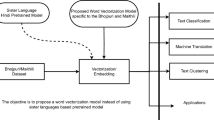Abstract
We propose an automatically word alignment method of Chinese-Vietnamese based on bidirectional RNN and linguistic features. With the bidirectional RNN, we can obtain the context information of both forward and backward direction. Moreover, some bilingual features are also integrated. In the process of training model. The experiments show that the approach proposed outperform the previous method, and suggests that linguistic features and context information can effectively enhance the effect of word alignment.
Access this chapter
Tax calculation will be finalised at checkout
Purchases are for personal use only
Similar content being viewed by others
References
Auli, M., Galley, M., Quirk, C., Zweig, G.: Joint language and translation modeling with recurrent neural networks. In: Proceedings of the Conference on Empirical Methods in Natural Language Processing (EMNLP), Seattle, Washington, USA, pp. 1044–1054 (2013)
Brown, P.F., Pietra, V.J.D., Pietra, S.A.D., Mercer, R.L.: The mathematics of statistical machine translation: parameter estimation. Comput. Linguist. 19(2), 263–311 (1993)
Dyer, C., Clark, J.H., Lavie, A., Smith, N.A.: Unsupervised word alignment with arbitrary features. In: Proceedings of the 49th Annual Meeting of the Association for Computational Linguistics: Human Language Technologies, Portland, Oregon, USA, pp. 409–419 (2011)
Gutmann, M., Hyvärinen, A.: Noise-contrastive estimation: a new estimation principle for unnormalized statistical models. In: Proceedings of the Thirteenth International Conference on Artificial Intelligence and Statistics (AISTATS 2010), Chia Laguna Resort, Sardinia, Italy, pp. 297–304 (2010)
Kalchbrenner, N., Blunsom, P.: Recurrent continuous translation models. In: Proceedings of the Conference on Empirical Methods in Natural Language Processing (EMNLP), Seattle, Washington, USA, pp. 1700–1709 (2013)
Mikolov, T., Karafiát, M., Burget, L., Ĉernocký, J., Khudanpur, S.: Recurrent neural network based language model. In: Proceedings of INTERSPEECH 2010 11th Annual Conference of the International Speech Communication Association, Makuhari, Chiba, Japan, pp. 1045–1048 (2010)
Mikolov, T., Zweig, G.: Context dependent recurrent neural network language model. In: In Proceedings of IEEE Spoken Language Technology Workshop (SLT), Miami, Florida, USA, pp. 234–239 (2012)
Mnih, A., Teh, Y.W.: A fast and simple algorithm for training neural probabilistic language models. In: Proceedings of the 29th International Conference on Machine Learning (ICML 2012), Edinburgh, Scotland, UK, pp. 419–426 (2012)
Mo, Y., Guo, J., Yu, Z., Luo, L., Gao, S.: A bilingual word alignment algorithm of Vietnamese-Chinese based on feature constraint. Int. J. Mach. Learn. Cybern. 6(4), 537–543 (2015)
Sundermeyer, M., Oparin, I., Gauvain, J.L., Freiberg, B., Schlüter, R., Ney, H.: Comparison of feedforward and recurrent neural network language models. In: Proceedings of IEEE International Conference on Acoustics Speech and Signal (ICASSP), Vancouver, BC, Canada, pp. 8430–8434 (2013)
Tamura, A., Watanabe, T., Sumita, E.: Recurrent neural networks for word alignment model. In: Proceedings of the Annual Meeting of the Association for Computational Linguistics (ACL), Baltimore, MD, USA, pp. 1470–1480 (2014)
Vogel, S., Ney, H., Tillmann, C.: Hmm-based word alignment in statistical translation. In: Proceedings of International Conference on Computational Linguistics (COLING), Copenhagen, Denmark, pp. 836–841 (1996)
Yang, N., Liu, S., Li, M., Zhou, M., Yu, N.: Word alignment modeling with context dependent deep neural network. In: Proceedings of the Annual Meeting of the Association for Computational Linguistics (ACL), Sofia, Bulgaria, pp. 166–175 (2013)
Yuanyuan, M., Jianyi, G., Zhengtao, Y., Cunli, M., Yitong, N.: A bilingual word alignment method of Vietnamese-Chinese based on deep neural network. J. Shandong Univ. (Nat. Sci.) 51(1), 77–83 (2016)
Acknowledgment
This work was supported by the National Natural Science Foundation of China (Grant Nos.61761026, 61732005, 61672271, 61472168), the Natural Science Fundation of Yunnan Province (Grant No.2018FB104), Innovation Talent Fund For Technology of Yunnan Province (Grant No.2014HE001).
Author information
Authors and Affiliations
Corresponding author
Editor information
Editors and Affiliations
Rights and permissions
Copyright information
© 2019 Springer Nature Singapore Pte Ltd.
About this paper
Cite this paper
Gao, S., Zhu, H., Wang, Z., Yu, Z., Wang, X. (2019). Chinese-Vietnamese Word Alignment Method Based on Bidirectional RNN and Linguistic Features. In: Sun, Y., Lu, T., Xie, X., Gao, L., Fan, H. (eds) Computer Supported Cooperative Work and Social Computing. ChineseCSCW 2018. Communications in Computer and Information Science, vol 917. Springer, Singapore. https://doi.org/10.1007/978-981-13-3044-5_33
Download citation
DOI: https://doi.org/10.1007/978-981-13-3044-5_33
Published:
Publisher Name: Springer, Singapore
Print ISBN: 978-981-13-3043-8
Online ISBN: 978-981-13-3044-5
eBook Packages: Computer ScienceComputer Science (R0)




